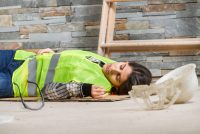Category: Injuries and Illness
Modern safety management goes beyond covering traditional workplace accidents to now being equally concerned with illnesses caused on and even off the job. This section will explain what you need to know to avoid both injuries and illnesses, and to track your progress in reaching this goal.
Free Special REport: Does Your PPE Program Meet OSHA’s Requirements?
Slips, trips, and falls are the third largest cause of workplace injuries, contributing to more than 100 million lost workdays and costing nearly $36 billion annually. The Montana State Fund has identified five contributing factors for slips, trips, and falls: Surface design. Slip resistance can have an important impact on preventing slips and falls. Slip […]
Slips, trips, and falls (STFs) are notorious workplace hazards that cause a lot of injuries and add to costs, productivity losses, and worker absences. Take action against STFs with these 5 strategies. Risk specialist Brian Roberts is the director of workers’ compensation and ergonomics for the insurance giant CNA. He’s developed an STF reduction strategy […]
Injury and illness prevention is always a big issue for safety professionals especially when incidents result in days away from work. Many companies are responding with injury and illness prevention plans. According to BLS, the total number of injury and illness cases requiring days away from work to recuperate was in 2011(the most recent year […]
Yesterday, we talked about preventing amputations. One of the best protections is machine guarding, the topic of today’s Advisor. The purpose of machine guarding is to protect the machine operator and other employees in the work area from hazards created by: Ingoing nip points Rotating parts Cutting and shearing Punching and bending Reciprocating and transversing […]
Slips and trips are an all-too-common occupational hazard estimated to cause hundreds of thousands of accidents and injuries on the job every year. The chief cause of slips is (no surprise) a slippery surface, compounded by improper footwear. There are two types of slips: In the first, the heel of the forward foot contacts the […]
Falls from heights are the leading cause of death in construction, and they cause many injuries and deaths in other industries as well. OSHA says that falls from heights can be prevented and employee lives can be saved if you take three simple steps: Plan Provide Train Plan Plan ahead to get the job done […]
Injury and illness prevention is always a big issue for safety professionals especially when incidents result in days away from work. Many companies are responding with injury and illness prevention plans. According to BLS, the total number of injury and illness cases requiring days away from work to recuperate was in 2011(the most recent year […]
A new study finds that simple health interventions can help reduce short-term disability rates as well as worker days away from work. According to a study of 118,000 American workers by health services company Cigna, a combination of predictive analytics and a nurse/health advocate-led intervention can produce a measurable reduction in future disabling illness or […]
Is it possible that your injury and illness records could be used against you as evidence of OSHA violations? The answer may surprise you. In a BLR webinar entitled "OSHA Recordkeeping: What’s Recordable and What’s Not," Adele L. Abrams, Esq., an attorney and nationally recognized expert on occupational safety and health, offered insight into the […]
Here are some exercises you can recommend to employees when you hold back safety meetings. These easy tune-ups can help condition and increase flexibility to prevent back injuries. WARNING: Advise employees to consult with their doctor before starting any exercise program. If they are badly out of shape or already have a back problem, some […]

